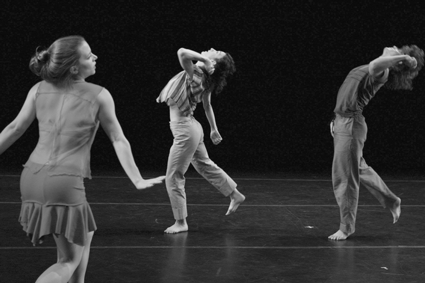Therapy dance themes help free the escape artists within
“Tell the world what you are and believe it, too.” This is one of the many philosophical one-liners riddled throughout “out of the kennel into a home,” created by Jeanine Durning and performed at Dance Theater Workshop September 28 through October 1.
In this dance performance, the audience got life lessons pounded into their heads with repetitive platitude shouting. “Reality is your sin!” “See yourself as others see you!” Maybe some of us don’t want to be lectured so, but it was enlightening nonetheless. Listening to a therapist give you the same line over isn’t the same as enduring demented cheerleaders screaming it in each other’s faces in front of you.
The piece began in pitch-black. Only a small light could be seen, and there were inaudible murmurings, which eventually were sourced to actor/playwright Keith Reddin, a strange, hyperactive man in suit and suspenders. While he was onstage, incoherently babbling, two young women (Molly Poerstel and Rachel Lozoff) stepped up and down the stairs to the stage incanting “Duh!” with rhythmic affinity that soon descended into chaos, and created an obnoxious effect—which seemed to be one of the themes of the piece. The girls rushed on stage. They yelled at each other––“You are not me! I am not you!” They hit each other and shouted, “Not there, not there!” They were mirror images, one in blue, one in red. They were the same persona. This was someone struggling to come to terms with herself. This was the internal dialogue externalized, and stuck in a rut.
Durning and Joe Poulson sat on stage during this exchange in a screened-in room, furnished with two chairs reading, oblivious. The man in the suspenders randomly showed up. The girls continued fighting. They punched and swung at the air, trying to harm themselves. The screaming became excruciatingly loud, almost unbearable. The room broke open. Durning sat motionless on one side of the stage and Poulson moved his chair to the other side of the stage, occasionally scribbling in a notebook resting on his lap. When the girls exited, Durning and Poulson danced; with a synchronic sensuality and power, the two matched each other’s intensity in two minutes of gorgeous dancing that could almost make up for the previous brow-beating.
Every once in a while, Andrea Johnston would appear from the center fold of the curtains, dancing a solo that suggested a peacefulness, a freedom from the duality of the human psyche.
In the second half of the piece, a connection was established between the girls and the couple, who did—finally—dance again. “You have to have a healthy relationship with yourself before you have a relationship with another person,” the message seems to be.
Parts of the performance were very drawn-out, with lengthy moments of silence and stillness. The ending was the most drawn out of all, reminiscent of watching Bugs or Daffy fake a dramatic death, but not nearly as entertaining. As the curtain drew closed like molasses dripping down a flat surface, Reddin ran back and forth, over and over and over again, until finally, the stage was black and he still took one final round trip run.
The performance was greatly enhanced by a live soundtrack by pianist/composer Jules Maxwell, which mixed music and sound effects with brilliant subtlety and engaged the edges of aural perception.
gaycitynews.com



































